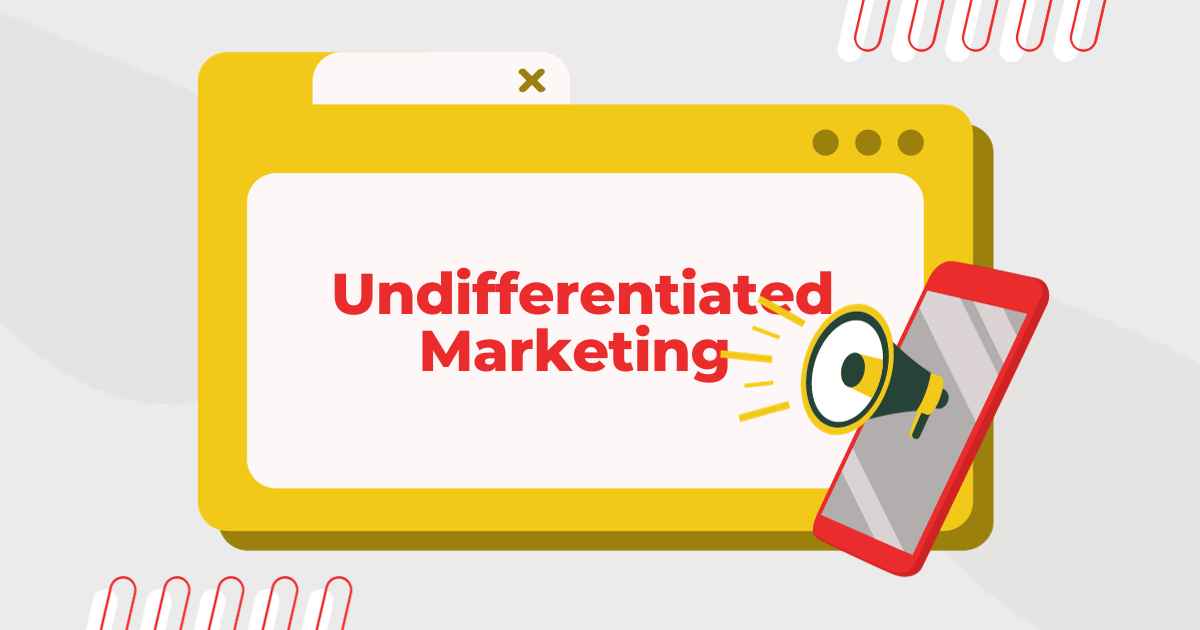In the world of marketing, there are several strategies that companies can adopt to reach their target audience. Undifferentiated marketing exemplifies this approach. This strategy, often referred to as mass marketing, involves treating the entire market as a single entity and promoting a single product or message to everyone.
What is Undifferentiated Marketing?
It is a marketing strategy where a company offers a single product or message to the entire market, without distinguishing between different segments or demographic groups. This approach assumes that the product or message will appeal to a broad spectrum of consumers and, therefore, aims to reach as many people as possible. It primarily relies on a “one-size-fits-all” concept.
Undifferentiated Segmentation
In this marketing, there is little to no segmentation. Segmentation is the process of dividing the market into distinct groups based on various factors such as demographics, psychographics, or behavior. However, treats the entire market as a single segment, operating under the assumption that there are no significant differences among potential customers that necessitate separate marketing strategies.
Undifferentiated Marketing Examples
- Coca-Cola: Coca-Cola is a prime example of a company that has historically employed undifferentiated. They market their flagship product, Coca-Cola, globally with a consistent brand image and messaging. The company aims to reach consumers of all ages, backgrounds, and preferences.
- McDonald’s: McDonald’s is another example of a company that employs undifferentiated. They have a core menu that is consistent across most of their locations worldwide, promoting the same products to diverse customer bases.
- Apple: While Apple primarily engages in differentiated marketing today, they initially used undifferentiated marketing when introducing groundbreaking products like the iPhone. At the time, their “one product, one message” approach was highly successful.
Undifferentiated vs. Differentiated Marketing
Here undifferentiated and differentiated marketing represent two ends of the marketing strategy spectrum.
Undifferentiated Marketing:
- Single product or message for the entire market.
- Assumes universal appeal.
- Cost-effective in terms of message and product development.
- Risky if the product doesn’t have broad appeal.
Differentiated Marketing:
- Targets specific market segments with tailored products and messages.
- Requires more resources for product and message customization.
- Reduces risk by addressing the unique needs of various segments.
- Frequently leads to increased customer satisfaction.
Undifferentiated Marketing Advantages
- Cost-Effective: Developing and promoting a single product or message reduces marketing costs, as there’s no need for segment-specific strategies.
- Simplicity: It’s a straightforward approach that requires less complexity in marketing planning and execution.
- Brand Consistency: It helps maintain a consistent brand image and message, which can be advantageous for brand recognition.
- Broad Reach: It aims to reach a large audience, potentially maximizing market share.
Undifferentiated Marketing Disadvantages
- Limited Personalization: It may fail to address the unique needs and preferences of specific market segments.
- Risk of Irrelevance: If the product or message doesn’t resonate with a significant portion of the market, it can result in poor ROI.
- Intense Competition: In highly competitive markets, undifferentiated marketing can make it challenging to stand out.
- Wasted Resources: It can lead to inefficient resource allocation, as marketing efforts may not connect with a significant portion of the audience.
Frequently Asked Questions (FAQs)
It is best suited for products or services with broad appeal, as it assumes that the product or message will resonate with a wide range of consumers. Niche or highly specialized products may benefit more from differentiated marketing.
Yes, companies often employ a hybrid approach. They may use marketing for brand awareness and combine it with differentiated strategies for product variations or special promotions.
Industries that often employ marketing include soft drinks (e.g., Coca-Cola), fast food (e.g., McDonald’s), and basic consumer goods (e.g., soap or toothpaste).
Market research is crucial. A company should evaluate the potential market and the extent of common needs and preferences among the target audience. If there’s a broad overlap, marketing may be effective.
Conclusion
Undifferentiated is a marketing strategy that focuses on mass appeal. While it has its advantages, it also carries risks, especially in an increasingly segmented and competitive marketplace. Companies need to carefully consider their product, target audience, and market conditions before deciding whether to adopt this approach. As the business landscape continues to evolve, a blend of undifferentiated and differentiated marketing strategies may often prove to be the most effective solution.
